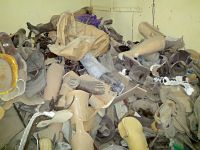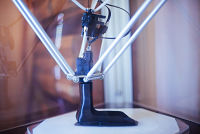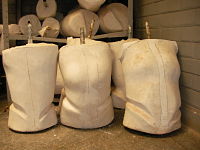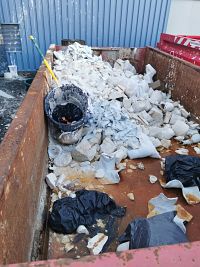The hidden cost of assistive devices
Artificial Limb and brace devices can be life changing for many people. They open the door to countless opportunities and contribute to the invaluable autonomy and independence of their users. However, making these devices often requires an incredible amount of energy and materials, many of which end up going to waste.
“To make an orthopedic device, we need a lot of plastic, metals, water, plaster, carbon, resin, etc.” says Abder Banoune, Humanity & Inclusion (HI) Rehabilitation Specialist.
“It takes a lot of energy, and a lot of people to make one simple device. Each one is custom-made for the user, and new ones must be made as people grow or their body changes. For example, many adults change artificial limbs every five years, but amputation is for life. So you can imagine how many devices one person would have in their cupboard after 40 or 60 years. Children need to change even more frequently (every 6 months or a year) since they grow more. This results in a lot of waste.”
HI is committed to providing access to quality rehabilitation care to people all around the world, while remaining conscious of our ecological impact. Low-income countries, where HI primarily intervenes, are disproportionately affected by the negative consequences of waste, climate change and environmental neglect, all of which magnify humanitarian needs. As part of our commitment to the populations we serve and to their environments, HI takes three approaches to limit waste and energy use in our provision of assistive devices.
Re-use / Second hand artificial limbs
“The idea of using second-hand artificial limbs came from HI’s Rehabilitation Director, Isabelle URSEAU after seeing the wasted devices in the field,” says Abder. “When I was working in Africa, the centers all had huge piles and containers full of destroyed or rusted devices that could not be re-used. They are just dumped in the backyard where they would stay forever.”
Rehabilitation Director, Isabelle URSEAU after seeing the wasted devices in the field,” says Abder. “When I was working in Africa, the centers all had huge piles and containers full of destroyed or rusted devices that could not be re-used. They are just dumped in the backyard where they would stay forever.”
In Lyon, France, HI operates a second-hand artificial limbs workshop called “La Poudrette” run by retired artificial limbs and braces professionals. The workshop receives used devices and dismantles them, conserving all of the re-usable components to be sent to HI’s programs to construct new ones.
“About 50-60% of the device can be re-used.”
“Sometimes, if you need to repair a device, you only need one part. Instead of buying new components or having to make an entirely new artificial limb, we can still use the parts that are good quality from the old ones,” Abder says.
La Poudrette has grown significantly since its creation and is now dismantling between 1000-1500 artificial limbs per year, with plans to double or triple their actions in the near future.
Reduce / 3D Printing
In 2016, HI became the first NGO to use 3D printing to make braces in low-resource settings. In Uganda, HI uses the innovative technology in refugee camps to scan individuals in need of orthopedic devices, and send the digital files off to be 3D printed in a separate location, without the recipient needing to travel to a rehabilitation center. Not only does this allow us to reach more isolated people, it also uses less energy and fewer materials than the traditional method of making brace devices.
When making devices the traditional way, a cast of the body is first made out of plaster. This plaster makes up much of the waste, as it is hard to recycle after the process. Plastic is then heated to 200 degrees Celsius to be shaped onto the plaster cast, before later adding components such as metal joints, foam, resin laminate and others. The process requires thousands of liters of diesel, a powerful generator, and a large center to house the equipment.
“3D printing is a unique approach to making orthopedic devices without needing huge equipment, lots of energy, or a lot of materials. It’s all virtual, so instead of using plaster, we can just scan the limbs. We don’t need a huge space and the printer only uses a small amount of energy- about three or four times less than the traditional method. In the future, I think we can power them by solar panels, which would not be possible traditionally. It’s ecological, the technology is very light, and it is inexpensive.”
devices without needing huge equipment, lots of energy, or a lot of materials. It’s all virtual, so instead of using plaster, we can just scan the limbs. We don’t need a huge space and the printer only uses a small amount of energy- about three or four times less than the traditional method. In the future, I think we can power them by solar panels, which would not be possible traditionally. It’s ecological, the technology is very light, and it is inexpensive.”
Recycle / Researching materials
Though 3D printing is emerging as a possible solution,  plaster-based creation is still the norm for most devices. The plaster required to make artificial limb devices is often shipped from abroad, can only be used once, and then unfortunately ends up in dumpsters. Gypsum, from which plaster is made, makes up 400,000 tons of waste worldwide. HI alone creates 5-10 tons of gypsum waste per year through artificial limb creation, and is determined to find a solution.
plaster-based creation is still the norm for most devices. The plaster required to make artificial limb devices is often shipped from abroad, can only be used once, and then unfortunately ends up in dumpsters. Gypsum, from which plaster is made, makes up 400,000 tons of waste worldwide. HI alone creates 5-10 tons of gypsum waste per year through artificial limb creation, and is determined to find a solution.
HI has partnered with the National Institute of Applied  Sciences (INSA), an engineering school in France, to conduct research to solve this problem. A program at INSA is currently performing experiments and studying efficient ways to re-use and recycle plaster.
Sciences (INSA), an engineering school in France, to conduct research to solve this problem. A program at INSA is currently performing experiments and studying efficient ways to re-use and recycle plaster.
Another research program is looking at ways to locally source and recycle materials such as plastic bottles or vegetable fibers to create the filament used in 3D printing.
“It’s important to find adapted, local solutions,” says Magdalena Szynkowska, HI Innovation Development Officer. “Every context might have different materials available, different vegetable fibers, and variety of types of plastic used in plastic bottles, so there may not be one single answer. It is complicated work, but I am confident that we will find solutions.”
 GREEN Initiative: HI is committed to reducing the adverse effects of climate change on vulnerable and marginalized populations worldwide. We help communities prepare for and adapt to climate shocks and stresses, and we respond to crises magnified by environmental factors. Applying a disability, gender and age (DGA) inclusion lens across all our actions, we advocate for practitioners and policy-makers to embed DGA in their climate work as well. HI is also determined to reduce its own ecological footprint by adapting and implementing environmentally conscious approaches to humanitarian action.
GREEN Initiative: HI is committed to reducing the adverse effects of climate change on vulnerable and marginalized populations worldwide. We help communities prepare for and adapt to climate shocks and stresses, and we respond to crises magnified by environmental factors. Applying a disability, gender and age (DGA) inclusion lens across all our actions, we advocate for practitioners and policy-makers to embed DGA in their climate work as well. HI is also determined to reduce its own ecological footprint by adapting and implementing environmentally conscious approaches to humanitarian action.



 Rehabilitation Director, Isabelle URSEAU after seeing the wasted devices in the field,” says Abder. “When I was working in Africa, the centers all had huge piles and containers full of destroyed or rusted devices that could not be re-used. They are just dumped in the backyard where they would stay forever.”
Rehabilitation Director, Isabelle URSEAU after seeing the wasted devices in the field,” says Abder. “When I was working in Africa, the centers all had huge piles and containers full of destroyed or rusted devices that could not be re-used. They are just dumped in the backyard where they would stay forever.” devices without needing huge equipment, lots of energy, or a lot of materials. It’s all virtual, so instead of using plaster, we can just scan the limbs. We don’t need a huge space and the printer only uses a small amount of energy- about three or four times less than the traditional method. In the future, I think we can power them by solar panels, which would not be possible traditionally. It’s ecological, the technology is very light, and it is inexpensive.”
devices without needing huge equipment, lots of energy, or a lot of materials. It’s all virtual, so instead of using plaster, we can just scan the limbs. We don’t need a huge space and the printer only uses a small amount of energy- about three or four times less than the traditional method. In the future, I think we can power them by solar panels, which would not be possible traditionally. It’s ecological, the technology is very light, and it is inexpensive.” plaster-based creation is still the norm for most devices. The plaster required to make artificial limb devices is often shipped from abroad, can only be used once, and then unfortunately ends up in dumpsters. Gypsum, from which plaster is made, makes up 400,000 tons of waste worldwide. HI alone creates 5-10 tons of gypsum waste per year through artificial limb creation, and is determined to find a solution.
plaster-based creation is still the norm for most devices. The plaster required to make artificial limb devices is often shipped from abroad, can only be used once, and then unfortunately ends up in dumpsters. Gypsum, from which plaster is made, makes up 400,000 tons of waste worldwide. HI alone creates 5-10 tons of gypsum waste per year through artificial limb creation, and is determined to find a solution. Sciences (INSA), an engineering school in France, to conduct research to solve this problem. A program at INSA is currently performing experiments and studying efficient ways to re-use and recycle plaster.
Sciences (INSA), an engineering school in France, to conduct research to solve this problem. A program at INSA is currently performing experiments and studying efficient ways to re-use and recycle plaster.

